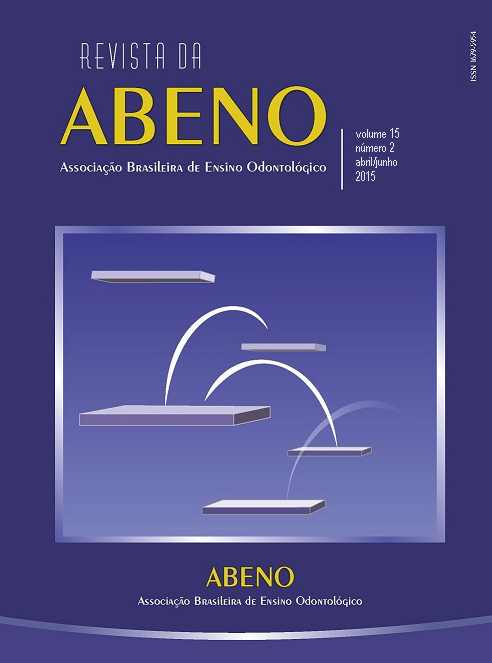Knowledge of leadership and management: pilot study of students perceptions of a dentistry course at a university in Brazil
DOI:
https://doi.org/10.30979/rev.abeno.v15i2.156Palavras-chave:
Leadership, Dental Education, Dental Students, Practice Management.Resumo
The Dentistry Course at UFPB was created in 1955. Although the course is recognized for its high-quality technical education in dentistry, through 2014, it has had no leadership and management subject, even though it is known that these skills are critical to the dentist. The aim of this research was therefore to evaluate the perceptions of knowledge about leadership and management of students in the fifth year of the UFPB dentistry course. Students answered a questionnaire and evaluated their current leadership skills on a scale from one (very poor) to five (excellent). On average, they rated themselves best on "Integrity" (4.42 points) and worst on "Advocacy skills" (2.38 points). The "ability to build others' trust" was the aspect considered most beneficial for an oral surgeon, representing 23.08% of responses, while "compassion" was the ability deemed least beneficial, with 34.62% of the responses. All students questioned agreed that it is important to create leadership and management subject in the UFPB dentistry course. Little knowledge of leadership and management has been demonstrated, as well as a great need for creating a leadership course at UFPB.
Downloads
Referências
de Albuquerque E L. José Américo de Almeida e as raízes do ensino superior na Paraíba. Inform. CRO-PB. 2010; 32(1):1.
Morita MC, Kriger L. Mudanças nos cursos de Odontologia e a interação com o SUS. Rev ABENO. 2004;4(1):17-21.
Kalenderian E, Skoulas A, Timothé P, Friedland B. Integrating Leadership into a Practice Management Curriculum for Dental Students; J Dent Educ. 2010;74(5):464-71.
Goleman D. Emotional intelligence: why it can matter more than IQ. New York: Bantam Books, 1995.
Narvai PC, Frazão P, Roncalli AG, Antunes AG, Leopoldo J. Cárie dentária no Brasil: declínio, iniquidade e exclusão social. Rev Panam Salud Publica. 2006;19(6):385-93.
Roncalli AG, Côrtes MI de S, Peres, KG. Oral health epidemiology and surveillance models in Brazil; Cad Saúde Públ. 2012; 28 Suppl:s58-68.
Goldstein AO, Calleson D, Bearman R, Steiner BD, Frasier PY, Slatt L. Teaching advanced leadership skills in com¬munity service (ALSCS) to medical students. Acad Med. 2009;84(6):754–64.
Morita MC, Kriger L, de Carvalho ACP, Haddad AE. Implantação das Diretrizes Curriculares Nacionais em Odontologia. 2ed. Maringá: Dental Press, 2013.
Institute of Medicine, Committee on Quality of Health Care in America. Crossing the Quality Chasm: A New Health System for the 21st Century. Washington, DC: National Academy Press; 2001.
Freixinho ABS, Chevitarese L. Abordagem na formação do cirurgião-dentista clínico geral para atuar no serviço público e privado. Revolução na prática de ensino [Approach to general practitioner dentist training for work in public and private service. A revolution in teaching practice]; Rev ABENO. 2010;10(1):14-8.
Brasil. Lei nº 12.711, de 29 de agosto de 2012. Dispõe sobre o ingresso nas universidades federais e nas instituições federais de ensino técnico de nível médio e dá outras providências [On admission to federal universities and federal institutions of middle level technical education and other measures]. Diário Oficial da União. 15 Aug 2012. Available at: http://legislacao.planalto.gov.br/legisla/legislacao.nsf/Viw_Identificacao/lei%2012.711-2012?OpenDocument
Downloads
Publicado
Como Citar
Edição
Seção
Licença
Autores que publicam nesta revista concordam com os seguintes termos:
a) Autores mantém os direitos autorais e concedem à revista o direito de primeira publicação, com o trabalho simultaneamente licenciado sob a Licença Creative Commons Attribution que permite o compartilhamento do trabalho com reconhecimento da autoria e publicação inicial nesta revista.
b) Autores têm autorização para assumir contratos adicionais separadamente, para distribuição não-exclusiva da versão do trabalho publicada nesta revista (ex.: publicar em repositório institucional ou como capítulo de livro), com reconhecimento de autoria e publicação inicial nesta revista.
c) Autores têm permissão e são estimulados a publicar e distribuir seu trabalho online (ex.: em repositórios institucionais ou na sua página pessoal) a qualquer ponto antes ou durante o processo editorial, já que isso pode gerar alterações produtivas, bem como aumentar o impacto e a citação do trabalho publicado (Veja O Efeito do Acesso Livre).






